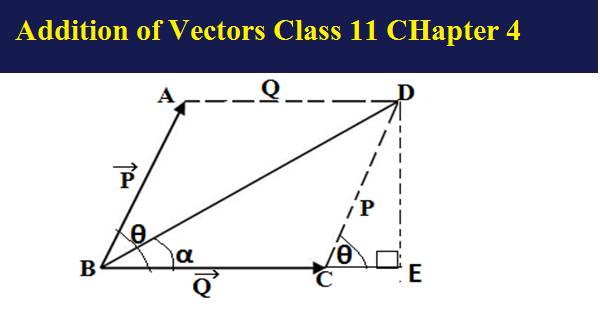Addition of Vectors: Class 11 Physics Chapter 4 CBSE
Triangular Law of Vector Addition: Following the rule of parallel shifting, draw one vector and then draw another vector such that the head of one vector is joined to the tail of another vector, thereafter joining the tail of the former vector to the head of the later vector, we get the resultant vector of both vectors which is the addition of the vectors.
As an example, a displacement of 3 m east and a displacement of 4 m north, then find the addition of the vector
Let the vector = 3 m east and
= 4 m north then their addition is
Hence the resultant of both vectors is 5 m northwest,so there are specific rule for vector addition,we can’t add them like the scaler quantity means the resultant can’t be 3 +4 =7
What is the resultant of two vectors when the angles between them is other than 90°
Let there be two vectors and
then their addition is represented as follows
The resultant R of both vectors is given as
The vector sum of both vectors is not a simple addition,the method mentioned above is head to tail method,apart from that there are other methods of solving vector addition.
The resultant of head to tail method is applicable when both vectors are in a same line or perpendicular to each other,so when both vectors have a certain angle θ between them then their resultant vecor is evaluated by parallelogram rule of vector addition.
Parallelogram Law of Vectors addition: In this method, two vectors are drawn tail to tail as they are adjacent sides of a parallelogram and then geometrically completing the parallelogram,then the diagonal obtained by joining the vertex of both vectors to the opposite vertex of the parallelogram shows their resultant.
Draw two vectors P and Q such that they join each other tail to tail
Complete the parallelogram ABCD, then draw a DE⊥CE
The sides AD =Q=AB,DC =P=AB shows magnitudes of the vectors
BD will show the resultant of the vectors
Let both vectors have angle θ between them and the resultant forms an angle of α between them and the magnitude of the resultant vector is R
Considering the right ΔBDE
∠ABC = ∠DCE=θ
BD² = BE² + DE²
R² =(BC+CE)² +DE²
R² = BC² +CE² +2BC.CE + DE²
R² = Q² + CE²+ 2Q.CE + DE²…….(i)
Let us find the value of CE and DE
Considering the triangle ΔDCE
cos θ =CE/DC and sinθ = DE/DC
CE = DCcos θ =Pcos θ …..(ii) and DE =DCsin θ= Psin θ …..(iii)
Putting the value of CE and DE in equation (i)
R² = Q² + (Pcos θ)²+ 2Q.Pcos θ + (Psin θ )²
R² = Q² + P²cos² θ+ 2Q.Pcos θ + P²sin ²θ
R² = Q² + P²(cos² θ+sin ²θ)+2Q.Pcos θ
R² = Q² + P²+2PQcos θ
The above equation is used for determining the magnitude of the resultant of two vectors
Now
tanα =DE/BE
BE =BC +CE =Q+ Pcosθ
From equation (ii) and (iii)
tanα = Psinθ/(Q+ Pcosθ)
This equation is used to determine the direction of resultant
Don’t forget to write a comment , subscribe us for the posts related to your study
Circular Motion: Angular velocity and angular displacement
Electronic Configuration of s,p and d orbitals
Atomic Radius Class 11 Chemistry Chapter 3 Periodicity in Properties
Why does Rainbow looks like a Bow?
NCERT Solutions of Science and Maths for Class 9,10,11 and 12
NCERT Solutions for class 9 maths
NCERT Solutions for class 9 science
NCERT Solutions for class 10 maths
Class 10 Maths Question Paper CBSE Half Yearly Exam 2022 With Solutions
CBSE Class 10-Question paper of maths 2021 with solutions
CBSE Class 10-Half yearly question paper of maths 2020 with solutions
CBSE Class 10 -Question paper of maths 2020 with solutions
CBSE Class 10-Question paper of maths 2019 with solutions
NCERT Solutions for Class 10 Science
NCERT Solutions for class 11 maths
| Chapter 1-Sets | Chapter 9-Sequences and Series |
| Chapter 2- Relations and functions | Chapter 10- Straight Lines |
| Chapter 3- Trigonometry | Chapter 11-Conic Sections |
| Chapter 4-Principle of mathematical induction | Chapter 12-Introduction to three Dimensional Geometry |
| Chapter 5-Complex numbers | Chapter 13- Limits and Derivatives |
| Chapter 6- Linear Inequalities | Chapter 14-Mathematical Reasoning |
| Chapter 7- Permutations and Combinations | Chapter 15- Statistics |
| Chapter 8- Binomial Theorem | Chapter 16- Probability |
CBSE Class 11-Question paper of maths 2015
CBSE Class 11 – Second unit test of maths 2021 with solutions
NCERT Solutions for Class 11 Physics
chapter 3-Motion in a Straight Line
NCERT Solutions for Class 11 Chemistry
Chapter 1-Some basic concepts of chemistry
NCERT Solutions for Class 11 Biology
NCERT solutions for class 12 maths
| Chapter 1-Relations and Functions | Chapter 9-Differential Equations |
| Chapter 2-Inverse Trigonometric Functions | Chapter 10-Vector Algebra |
| Chapter 3-Matrices | Chapter 11 – Three Dimensional Geometry |
| Chapter 4-Determinants | Chapter 12-Linear Programming |
| Chapter 5- Continuity and Differentiability | Chapter 13-Probability |
| Chapter 6- Application of Derivation | CBSE Class 12- Question paper of maths 2021 with solutions |
| Chapter 7- Integrals | |
| Chapter 8-Application of Integrals |
Class 12 Solutions of Maths Latest Sample Paper Published by CBSE for 2021-22 Term 2
Class 12 Maths Important Questions-Application of Integrals
Solutions of Class 12 Maths Question Paper of Preboard -2 Exam Term-2 CBSE Board 2021-22
Solutions of class 12 maths question paper 2021 preboard exam CBSE Solution







